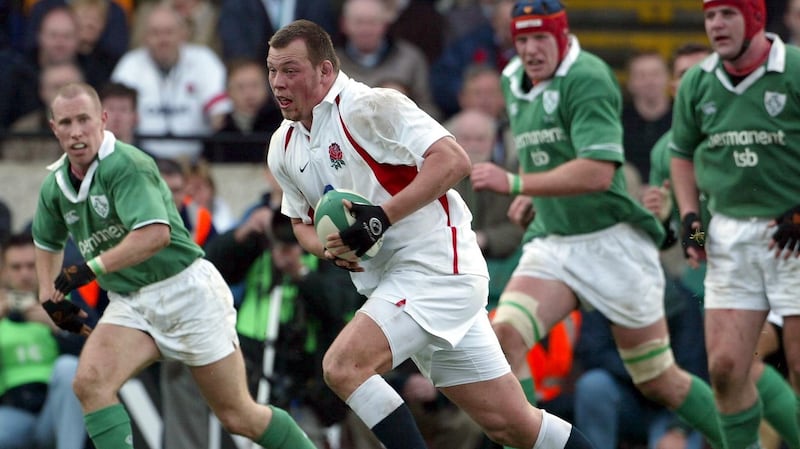The heartbreaking stories of former England internationals Michael Lipman and Steve Thompson, who are dealing with the horrors caused by brain trauma, were deeply confronting. It is impossible not to be moved by their situation.
In recent years World Rugby has taken some credible steps in dealing with concussion. Despite these efforts, everyone linked with the game knows that many more significant changes to the laws and concussion management for player safety are essential.
In Ireland's recent match against Scotland, anyone who witnessed Andrew Porter, with Iain Henderson bound to his back, running at full pace and smashing into Stuart Hogg to clear him out, will know the game must change. Hogg was bent over a tackled Irish player, "jackling" for the ball. It is an extremely dangerous and vulnerable position. Under the law it was a legal act and Porter and Henderson are blameless. How Hogg stood up uninjured after that collision was miraculous.

That sickening type of collision happens multiple times in every game. World Rugby must use great wisdom but they must act swiftly to change the law to make the tackle contest safe.
In the 1980s rugby went through a similar period of crisis regarding player safety. Many players across the globe suffered serious spinal injuries during scrums. With law changes and player education, scrums are now very safe.
Caution to change the laws needs to be balanced with haste because rugby must ensure that the present generation of players do not walk down the same path as Lipman and Thompson.
Despite the current narrative being pushed across the globe, the responsibility of how rugby reached this crisis point does not rest solely on the shoulders of the law makers.
There is an aspect to these terrible stories in this concussion crisis that belongs to the individuals.
The men who are now dealing with brain trauma were mature adults when they were suffering repeated concussions. Some were senior internationals. Why did they not stop playing? Why did they continue playing into their mid-30s with repeated concussions?
Where was their personal responsibility for their own health in their playing days?
Michael Lipman was born in England and brought up in Australia. I knew Michael during his schoolboy days at St Joseph’s College in Sydney and we met during his playing days in England where he played for Bath and England, before returning to play Super Rugby in Melbourne.
Michael is a very good man.
In July 2012, he did an interview for the Sydney Morning Herald with journalist Stathi Paxinos. The words from that interview now make very uncomfortable reading.
“The openside breakaway [flanker] estimates he has had more than 30 cases (of concussion) throughout his career.
“I don’t regret it at all. It was my decision to keep going,’’ says Lipman. “A couple of professors said you should retire but I always thought there was a lot more rugby in me and I didn’t really think anything of it at the time.
“I probably should have [told Bath about the medical advice] but at the same time I wanted to keep playing and I wanted another contract,’’ he says. “If you let them know that you have got this advice, then they’ll never give you a contract. So you’ve got to keep it to yourself, because at the end of the day I want to play rugby and to do that you’ve got to hold things in, and that was all my decision.
“When I had medicals [for the Rebels] I told them I’ve had a few knocks here and there but never really told them the true extent of what it was, but you’ve got to do that to get a contract.’’
“I really should have hung up the boots, but Melbourne were really great and gave me the opportunity.
“I was like, ‘I’m a rugby player, I’m going to keep playing because that’s what I do’. I loved the game and just wanted to keep doing it and I thought that was the right decision.”
I am very surprised that these words never found their way into the current conversation regarding brain trauma in rugby.
From this interview, it is obvious, that Michael was aware of his repeated concussions during his playing days.
I suspect those words do not fit into the current politically accepted narrative that all the blame for head trauma sits entirely with the game and those who were playing are blameless for their circumstance.
Last year I spoke to a former All Black, who told me he had multiple concussions and he hid many from the medical staff.
I have heard that story from so many players. They hid their concussions and the symptoms from family, coaches and medical staff because they wanted to keep being selected to play.
To admit to being concussed was to miss selection, or worse to miss a contract.
There is no argument that World Rugby must change many laws and a multitude of concussion protocols but I am convinced that current and future players must be better educated so that the individual has the power and knowledge to make the correct decisions surrounding their brain health than past generations.
What I am sure of is that no player must ever again be allowed to reach the level of damage that Thompson, Lipman and others appear to have been allowed to reach.
Every individual player from the junior clubs, through the AIL, up to the highest levels of the international game have a responsibility to understand the risks and the great joys of playing. Then base their decisions on medical science, not newspaper articles. None of which, including this one, are scientific papers on concussion.
Which brings us to the baseless conspiracy myth that is attempting to drive fear across the rugby community. This false narrative attempts to connect the failings in American NFL, brought to life with dramatic terror in the movie “Concussion” and link these horrific practices directly to rugby.
CTE (chronic traumatic encephalopathy) is a degenerative brain disease that was found during post mortem dissections of NFL players’ brains. CTE was found in these past players who were exposed to horrific coaching practices that caused devastating brain injuries.
Those NFL players were coached to drive their heads, straight into the chest of their rushing opponent or to tackle, by aiming their heads at the runner’s knees. They did this repeatedly from the ages of 10 or 12 until they retired in their 30s. At every practice and game, day after day, week after week, year after year, they drove their heads, with full force, into the middle of their opponent’s chest or at their moving knees.
These horrific coaching concepts, in no way shape or form, have even the slightest resemblance to any coaching methods in rugby. Any attempt to reference rugby and what occurred in the NFL’s past and the movie “Concussion” needs to be called out for what they are – baseless, scaremongering lies.
CTE is real. Concussions and brain injury have happened in rugby far too often, but I have never witnessed or heard of any rugby coach telling his or her players to use their head as a weapon on contact. Rugby educates players to do the exact opposite and place your head behind the ball carrier, not in front.
Brains in rugby are injured by other factors besides physical trauma.
I played with three men who now have serious cognitive damage. All have a long history of alcohol and substance abuse.
We know that excessive abuse of alcohol or drugs can cause damage to the brain and accelerate cognitive decline. A medical research study in Winnipeg Canada and published in the National Library of Medicine found that a staggering 35 per cent of the general population over 40 years of age had CTE at autopsy. This is commonly associated with drug and alcohol abuse. The authors say: “We conclude that CTE-like findings are not confined to professional athletes; the risk factors of head injury and substance abuse are similar in the routine population.”
If there was ever a sentence that tells you that the narrative on this incredibly important topic has been injected with zealots’ fear and we, the rugby community, have not been provided with exact medical science, that’s it.
A leading Australian sports lawyer told me that any legal action regarding brain trauma and rugby will examine, with forensic detail, players’ past habits with alcohol and substances.
There are many rugby players, past and present, whose relationship with alcohol and substances has not been healthy for their brain. That is the harsh reality.
The English Rugby League great James Graham has pledged his brain to science to aid in concussion research. When asked if he was worried if his playing days would have an affect on his brain in later life, he answered, “It’s my brain. I will do with it what I want.”
It is essential that today’s and tomorrow’s players are educated to do not only what they want with their brains, but to do what is right.














